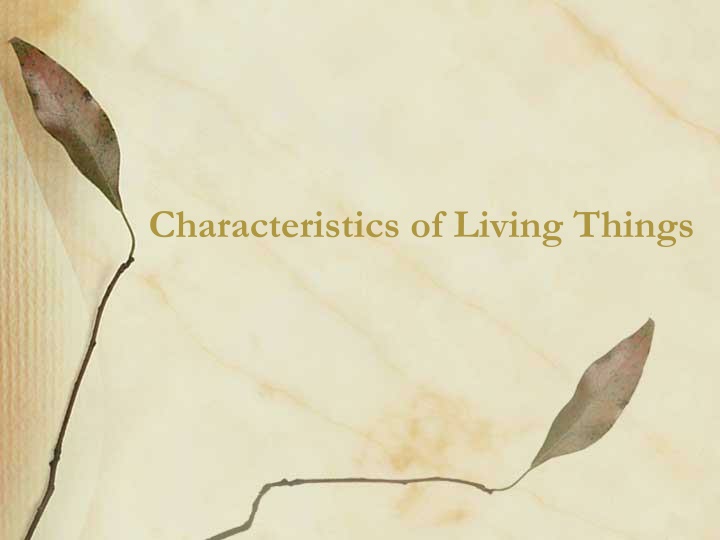
Characteristics of Living Things
Explore the essential characteristics of living things and life functions, including nutrition, transport, respiration, excretion, regulation, growth, reproduction, synthesis, and metabolism. Understand how organisms obtain and process food, circulate and absorb nutrients, release energy through respiration, and eliminate cellular wastes for optimal functioning.
Download Presentation

Please find below an Image/Link to download the presentation.
The content on the website is provided AS IS for your information and personal use only. It may not be sold, licensed, or shared on other websites without obtaining consent from the author. If you encounter any issues during the download, it is possible that the publisher has removed the file from their server.
You are allowed to download the files provided on this website for personal or commercial use, subject to the condition that they are used lawfully. All files are the property of their respective owners.
The content on the website is provided AS IS for your information and personal use only. It may not be sold, licensed, or shared on other websites without obtaining consent from the author.
E N D
Presentation Transcript
Life Functions The processes of activities, common to all living things. An organism is considered to be alive as long as its cells perform certain life functions. Nutrition Transport Respiration Excretion Regulation Growth Reproduction Synthesis Metabolism
Nutrition A life process where an organism obtains (gets) and processes food. Some organisms, such as green plants, can make their own food. Autotrophs Other living things must obtain their food already formed. Heterotrophs
Nutrition Food is taken in from the environment by ingestion. Ingested food is not usually in a form that can be used by the body and must be changed into a usable form.
Nutrition Digestion is the process that changes food into a form that can be used by the cell. During digestion, large complex molecules are broken down into small simple molecules.
Transport The life process involved with the circulation and absorption of nutrients. Nutrients are the parts of food that can be used by the cell. The movement of materials within the cells or throughout an organism is circulation.
Transport During absorption, usable materials are taken into the cell. Along with nutrients, oxygen, water, and wastes are transported throughout a cell or organism.
Respiration A complex series of chemical reactions that releases energy for life activities. An organism s energy is stored in food nutrients. Most organisms need oxygen for respiration Aerobic Organism A few organisms do not need oxygen for their respiratory processes. Anaerobic Organisms
Excretion Life processes result in the formation of cellular wastes. These wastes are harmful to the organism and must be removed. Products commonly excreted from cells are carbon dioxide and water. Egestion is the process that removes undigested materials from the body. Do not confuse the process of egestion (getting rid of solid wastes), with excretion (the elimination of gaseous or liquid wastes of cellular respiration).
Regulation The life activity responsible for the control and coordination of all the various activities of an organism. The nervous and endocrine systems are responsible for regulation.
Regulation Regulation allows organisms to respond to changes in the environment. They can find food, avoid danger, respond to light. A change in the internal or external environment is known as a stimulus (light, temperature, etc).
Synthesis Living things are able to produce complex substances from simple substances by the process of synthesis. During this process, the simple food molecules produced during digestion are put together to make the complex materials needed by the organism. Example: During photosynthesis, green plants make complex compounds (sugar) from simpler materials.
Growth Growth results from synthesis. Growth is an increase in size and/or number of cells of an organism. The complex materials produced during synthesis are used for growth. When cells grow, the size of the cytoplasm changes, but not the size of the nucleus. Day 1 Day 5
Reproduction The production (making) of new organisms. This is the only life process that is not necessary for the life of an individual organism. It is necessary for the continued existence of a particular group of organisms. Cells reproduce by cell division. Cell division involves a series of changes in the cell leading to the production of two new cells. In organisms made up of many cells, the production of new cells also results in the growth and repair of damaged tissues.
Metabolism All the processes needed by an organism to maintain life are known as metabolism. Metabolism is the total of all the processes taking place within the cells of an organism.
Homeostasis The maintenance of a stable internal (inside) environment in spite of changes in the external (outside) environment is called homeostasis. When the body is in homeostasis, it is in a balanced or steady state (condition).






















